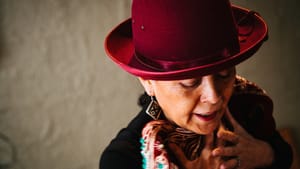Stay in the Loop
BSR publishes on a weekly schedule, with an email newsletter every Wednesday and Thursday morning. There’s no paywall, and subscribing is always free.
A life in rhythm
Philly Fringe 2019: Pasión y Arte presents Elba Hevia y Vaca’s ‘La Bolivianita’

La Bolivianita is new performance from feminist flamenco artist Elba Hevia y Vaca, her first solo show. Choreographed by Hevia y Vaca and directed by Belen Maya, a fellow flamenco artist and choreographer, this autobiographical piece explores identity and personal and artistic development through the rhythms and traditions of flamenco, the Spanish folkloric art of dance, music, and song. More than a year in development, La Bolivianita both draws from and subverts these traditions in order to tell the story of a woman—a mother, a daughter, an immigrant, a feminist, an artist—becoming herself through dance.
Hevia y Vaca uses flamenco as a lens for approaching the personal and the political, expressing global and individual issues, and bridging nations and cultures. La Bolivianita takes strides toward all of these. A mesmerizing dancer with a commanding yet luminous presence, Hevia y Vaca weaves together complex threads of history and emotion through alternating words and movement.
The power of rhythm
On opening night, there was more conversation than I expected, and the living-room feel of the venue, where seating included couches, supported the La Bolivianita’s intimate ethos. The performance included direct addresses to the audience that interspersed stories of Hevia y Vaca’s life with information about the intricate components of flamenco, from palo (musical forms) to compas (rhythm and meter). Need more convincing of flamenco’s complexity? Hevia y Vaca led a participatory series of palmas (percussive hand claps) that demonstrated the power of sharing rhythm and also quickly challenged the audience.
She calls flamenco “my anchor” and “my best friend,” a way of getting inside herself, healing from childhood trauma, making sense of injustice, and loving herself in a world that tends not to be loving to women, immigrants, people of color, and women artists. When Hevia y Vaca puts on a Bolivian bowler hat and dances to music from her hometown of La Paz, she embodies a multitude of identities and reminds viewers of the many selves inside us all.
Born again through dance
La Bolivianita also offers a fascinating glimpse into Hevia y Vaca’s development as an artist. Years of formal study of a highly structured art form led her to break flamenco’s rules and revision it as a means of feminine expression, empowerment, and creativity. She transforms the traditional mantón into a saintly halo as well as a trap she seems stuck inside. The long skirt of the bata de cola signifies the female body with ruffles in shades of red and pink. When Hevia y Vaca dives inside it, she emerges as if born again through dance.
These images are beautiful and inspiring, yet La Bolivianita may take on too much. At times it seems more like a work in progress still looking for its anchor, as it alternates between movement, storytelling, and discussion of flamenco. But Hevia y Vaca gracefully and energetically rises to the performance’s challenge.
What, When, Where
La Bolivianita. Choreography by Elba Hevia y Vaca, directed by Belen Maya. Pasión y Arte. Through September 22, 2019 at exuberance, 1220 N. Mascher Street, Philadelphia. (215) 413-1318 or fringearts.com.
Sign up for our newsletter
All of the week's new articles, all in one place. Sign up for the free weekly BSR newsletters, and don't miss a conversation.

 Melissa Strong
Melissa Strong